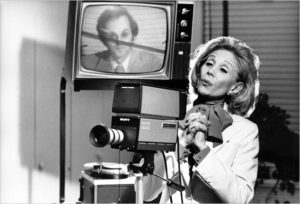
by Beth Levine | Oct 5, 2019 | preparing for a presentation, public speaking
 I was captivated recently by an article in National Geographic’s Secrets of Animal Communication. In particular, this passage on the first page really stuck with me:
I was captivated recently by an article in National Geographic’s Secrets of Animal Communication. In particular, this passage on the first page really stuck with me:
Communication might even be conceived … as anything that’s evolved to transmit information, with “information” defined as a reduction of uncertainty. Understood in this way, communication is found in the speckles on a trout’s flank and the courtship displays of whooping cranes, the abdomen-wagging dances of honeybees and – yes – monkey alarm calls … Cues, signals, messages – communication is everywhere, and life is a constant gathering of information.
A constant gathering of information, thereby reducing uncertainty. Amazing definition! At a very primal level, information is meant to reduce the unknowns, to guide us, to give us signals – via sight and sound – for knowing, deciding, engaging. Wow, let’s hold that thought for a minute.
When we gather information – in meetings and presentations – does it typically reduce uncertainty? Doesn’t it sometimes (or often) increase uncertainty? Obfuscate? Blur? Confuse?
What if we shared information only with the intention, or to the extent, that we would reduce uncertainty – or, to be more positive about it – to ensure certainty? Instead of giving in to the urge to be thorough or to prove that we’re the smartest person in the room, we would communicate – with our body language and our words – more deliberately and strategically, wouldn’t we?
We would indeed. So here are three of SmartMouth’s tips to help us be more deliberate and strategic with our information:
1. Cues. The best way to reduce uncertainty is to guide your audience each step of the way. Tell them when your introduction is over, when you’re making and concluding your first main point, when you’re digressing to tell a story, when you’re transitioning from one point to another, and when something you’re saying is more important than the rest. Drop little breadcrumbs along the way so they can track and know where you are and what they’re supposed to remember.
2. Signals. Decide that you’re going to show up, be present and let the audience know you want to be with them. If you make a conscious decision ahead of time that you’re going to relax and enjoy your time, it is more likely to happen and your audience is more likely to engage with you. And smile – it’s probably the best non-verbal signal you can send.
3. Messages. Information, defined as evidence, background or detail, is meant to support a point or message. Know your what your message is, and then, to support it, decide how much and what kind of information your audience can tolerate and digest … in order to reduce uncertainty. TMI, or too much information, is in the eye of the beholder, your audience! (Ask yourself: are they in the room by choice or obligation? If by choice, you have more latitude with info; if by obligation, limit it.)
Check yourself and be honest: Are you reducing uncertainty when you speak and share information or are you making the waters murkier for your audiences? We get a lot of wisdom about ourselves from our observations of the animal kingdom, but this particular gem, that info = reduction of uncertainty, is particularly poignant in a world of TMI. Like animals, our communication is via sight and sound, so let’s make sure we reduce uncertainty with both.

by Beth Levine | Sep 24, 2019 | preparing for a presentation
 Q: Given all the best practices and well-known tips for public speaking, is there a style everyone should try to emulate and master?
Q: Given all the best practices and well-known tips for public speaking, is there a style everyone should try to emulate and master?
A: No.
Coaching people to be better speakers and presenters is delicate business. People are sensitive, they have pride and egos – and not in a bad way, but in a very good way. If someone has reached the point where they need to be more impactful at the front of the room, either they’ve earned it or they’re showing great potential. In other words, they have every right to be prideful and (appropriately) protective of their ego.
There are coaches out there who work to mold their coachees into a certain speaking style they view as the gold standard. It can be awkward or, at the very least, difficult for the coachee to achieve; it’s just not them. I don’t hold people to a standard. I believe (quite strongly) that every individual is at their best only when she or he strives to be their best self.
Let’s be honest, not every turn at the front of the room is a TEDTalk, nor is it the Gettysburg Address. Very few people are offering inspirational keynotes. Most people who speak in front of groups need and want to be effective in order to advance their work. They want to be clear, concise and impressive. This automatically removes the need to emulate someone erudite and profound like Winston Churchill or someone with the magnetic delivery of a Ronald Reagan or a Barack Obama. Which means there’s no need for a gold standard.
If you are in the position of offering a friend or colleague some advice, or if you’re the person asking for advice, I want you to use what I use, which is the “best self” standard. Let’s break that down …
Best. One of Merriam Webster’s definitions of best is the greatest degree of good or excellence.
Self. Self is defined as an individual’s typical character or behavior.
Taken together, the goal is to achieve the greatest degree of good or excellence for an individual’s typical character or behavior. In public speaking, this means looking for the person’s strengths and drawing those out more plus flagging the weaknesses so the speaker can be more self-aware and ready to avoid them.
Telling someone to “say that like Jenny does” or “do what Bob does” isn’t helpful. Telling them “you are so much more engaging when you get passionate” or “remember to slow down when you want your audience to hear every word in your sentence” is specific to them and therefore so much more attainable.
The point is to begin with the person and mold them into the best speaker they can be, not to begin with a speaker or mold in mind and squeeze the person into that. The goal is best self, not best speaker.
by Beth Levine | Sep 3, 2019 | preparing for a presentation, public speaking
 For those of you who are rabid college football fans, avert your eyes, click out of this, go do something else. This article is not for you.
For those of you who are rabid college football fans, avert your eyes, click out of this, go do something else. This article is not for you.
If you’re like me, though, and you’re a sports enthusiast except when it comes to football, you might be looking for a diversion. Like me, you could be facing three months in which you’ll be hearing the ambient noise of football – because it’s constantly in the background or you’re passively watching with a loved one or you’ve agreed to meet friends at a local pub to watch (but only because you wanted to see your friends) – and you’re looking for something constructive to do for those three tedious hours. Look no further, I have just the thing!
College football, as all sporting events are, is an opportunity to hone your presentation skills. Yep, your presentation skills. Simply by watching and learning. So, here’s a heads-up on three aspects of athlete and coach communications that make great “notes to self” about how you want to (or not) present yourself:
Handling Q&A. Half-time and post-game interviews are a microcosm of what happens during Q&A in business settings. There are the usual, predictable questions that get asked every single time. There are also the out-of-left-field, are-you-kidding-me questions that no one is quite sure how to handle. And there’s everything in between. Watch and listen, you can probably learn something from both ends of the questioning spectrum. In particular, this: When you get asked the usual, predictable questions, are you curt and short because you’ve said it a hundred times (like some athletes and coaches are), or do you take your time to give a robust and substantive reply? I hope it’s the latter, because it may be old hat to you but you never know who’s hearing it for the first time.
Handling Victory. Post-game interviews with the victors are a fascinating thing to watch. Depending on the game, some athletes and coaches are so elated, they can barely formulate a full sentence. Still, it’s fun because they communicate with their ebullience. Other winners, and I can think of a few coaches as I say this, show imperceptible signs of the happiness you would expect to accompany a victory. Those are the interviews you watch and you’re not sure if you’re listening to the winning or losing coach. As with most things in life, the key is moderation: In other words, when celebrating a victory and communicating your feelings about it, the key is finding the balance between being joyful and being humble/gracious.
Handling Defeat. There are so many great examples of how to and how not to handle defeat in sports. We’ve all seen some players and coaches take roads so high we didn’t even know such thoughtfulness and eloquence were possible. And we’ve seen some who mumble, hang their heads and walk out of the room. Even though there’s a 50% chance of defeat in team sports, no one enters the game thinking it will be them (or if they think it will be them, they enter the game thinking positively and hoping for a miracle on the field!). No doubt, it’s hard to give the post-game interview after a loss. Watch and listen for things like graciousness versus defensiveness; responsibility versus blame; and hopeful versus fatalistic responses about the future. No need to harp on which is better, which sounds better, and which is better for reputation-building … you’re a time-tested audience member, you get it!
Pay attention to how reporters talk about, speculate and evaluate what players and coaches say and have said. Their observations – even with the ridiculously intense nonstop scrutiny – are also interesting and informative. They offer a window on what your audiences want to see and hear from you.
Enjoy college football this fall, and I hope you decide to join me in some armchair presentation coaching!
by Beth Levine | Jul 10, 2019 | Just Mouthing Off, public speaking
 I’m so proud of my client! Let’s call him John.
I’m so proud of my client! Let’s call him John.
Over the past three months, John has been successful in adapting his communication style and effectiveness so much that it’s noticeable to (and appreciated by) his colleagues and superiors. Quite simply, he has started to use inquiry + listening for understanding before disagreeing or talking.
John is passionate about his work. He’s also incredibly smart. However, he had been getting mixed feedback about his communication style in meetings. Seems that some of his colleagues felt he talked too much and took too long get his thoughts out. Others believed he was thoughtful and measured and thorough. (Long-windedness is apparently in the ear of the beholder!) He was confused and frustrated, unsure of how opinions (gathered in a 360 performance appraisal) could be so divergent.
His boss reached out to me, hoping I might be able to help him communicate in a way that is more collegial and concise. She told me John is a highly skilled and valued manager, but that his style in meetings verged on pontificating and many found it overbearing. She had talked to him about it, and they agreed to get him some coaching.
Luckily, John was super self-aware and also motivated to improve. When we began working together, he and I dove into why and how he tended to make his longer, more involved points during meetings. Turns out, it came from a sincere place – his passion for his organization’s work and his drive to achieve good outcomes. Fair enough. What we worked on was basically audience-centricity, or putting the audience first. We did that in three ways:
- Using inquiry: Asking questions of other people so he could draw out context, examples and perspective. It helps avoid misunderstandings and makes others feel as though they’ve been heard. Inquiry surfaces material for better, more informed dialogue and decision-making.
- Listening for understanding … versus listening for responding: Being open and empathetic in how he pays attention to other speakers in the room. Most of us listen with only half an ear; the other half is busy formulating or finessing a response. Listening for understanding requires that you stop composing your response or put aside thoughts of responding until after you’ve assimilated what the speaker has said.
- Disagreeing diplomatically: Offering up an opposing view in a constructive way on those occasions when John disagreed with what he was hearing. This involves a combination of 1) repeating what you heard and understood from others to be sure you got it right, and 2) articulating the shared opinions or shared goals you have with the other speaker(s). After those two steps, which empathize and build connection, you are free to share your view.
Just like the old saying, “look before you leap,” you should also think before you talk. You may have a strong position or a lot to say, but your colleagues and clients want and need to be heard and understood first. It’s all about them, your audience, because you can’t and won’t achieve your goals without them.
by Beth Levine | Jun 24, 2019 | public speaking
 Like ESPN Classic, I occasionally like to showcase some of the best advice from early practitioners of speaker coaching. Because visuals have become an expected accompaniment to most talks – and practically synonymous with the word “presentation” – I’d like to share a few poignant tips on using visuals from Dorothy Sarnoff (1914-2008).
Like ESPN Classic, I occasionally like to showcase some of the best advice from early practitioners of speaker coaching. Because visuals have become an expected accompaniment to most talks – and practically synonymous with the word “presentation” – I’d like to share a few poignant tips on using visuals from Dorothy Sarnoff (1914-2008).
Dorothy Sarnoff was an opera singer and Broadway star who had a much bigger second career as one of the first, and most influential, image consultants and self-help gurus. She advised presidents, prime ministers, political candidates and actors on how to become better public speakers.
She began her consulting career in the 1960’s. She bemoaned the fact that women’s magazines focused only on beauty and clothes and not on areas like poise and voice quality. Sarnoff was soon offering a course at a New York City department store called Speech Cosmetics. Students (mostly women) paid $25 for six classes designed to help them become better public speakers, to “achieve social poise” and to carry on conversations at parties. By the mid-1970s, her clients were paying her $1,000 for coaching sessions and $2,000 per lecture. She famously coached then-candidate for President Jimmy Carter to tone down his smile.
Regarding the use of visuals, Dorothy Sarnoff had these three practical pieces of advice:
“The next time you use visual aids, in deciding whether to use each one, ask yourself: Do I need it? Nine times out of ten the answer is no.”
“Most people say they use visuals to emphasize a point. You don’t need visuals for that. Emphasize your point with your voice and forget the slides.”
“Depending on visual aides to get your message across sends a signal right off the bat to the audience: your written material, your personal chemistry, or both, aren’t up to the job.”
Once again, it comes down to this: You are responsible for your presentation, not your laptop or your deck. Spend more time on making sure YOU are ready, rather than on perfecting your slides.

 I was captivated recently by an article in National Geographic’s Secrets of Animal Communication. In particular, this passage on the first page really stuck with me:
I was captivated recently by an article in National Geographic’s Secrets of Animal Communication. In particular, this passage on the first page really stuck with me:

 Q: Given all the best practices and well-known tips for public speaking, is there a style everyone should try to emulate and master?
Q: Given all the best practices and well-known tips for public speaking, is there a style everyone should try to emulate and master? For those of you who are rabid college football fans, avert your eyes, click out of this, go do something else. This article is not for you.
For those of you who are rabid college football fans, avert your eyes, click out of this, go do something else. This article is not for you.  I’m so proud of my client! Let’s call him John.
I’m so proud of my client! Let’s call him John.  Like ESPN Classic, I occasionally like to showcase some of the best advice from early practitioners of speaker coaching. Because visuals have become an expected accompaniment to most talks – and practically synonymous with the word “presentation” – I’d like to share a few poignant tips on using visuals from Dorothy Sarnoff (1914-2008).
Like ESPN Classic, I occasionally like to showcase some of the best advice from early practitioners of speaker coaching. Because visuals have become an expected accompaniment to most talks – and practically synonymous with the word “presentation” – I’d like to share a few poignant tips on using visuals from Dorothy Sarnoff (1914-2008).

